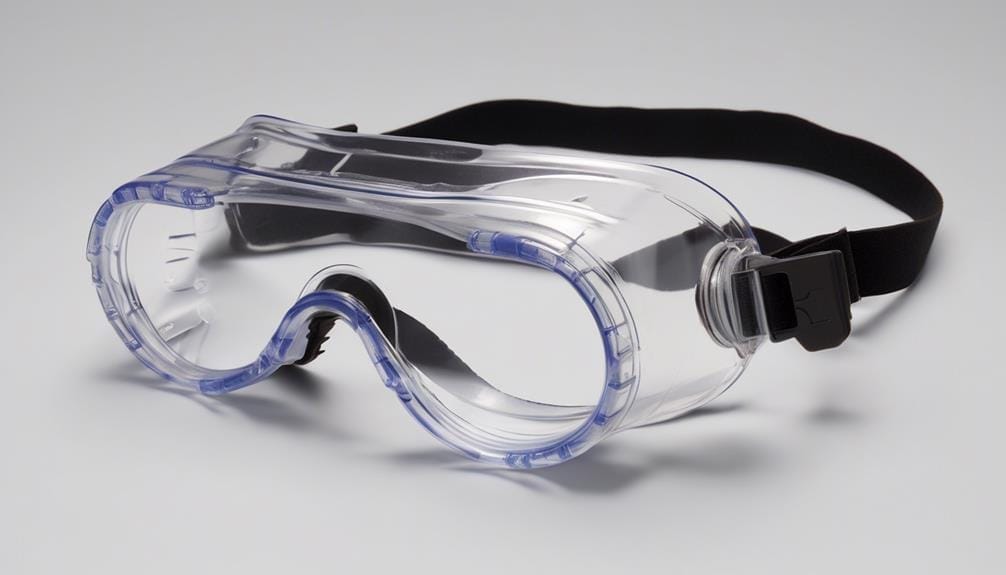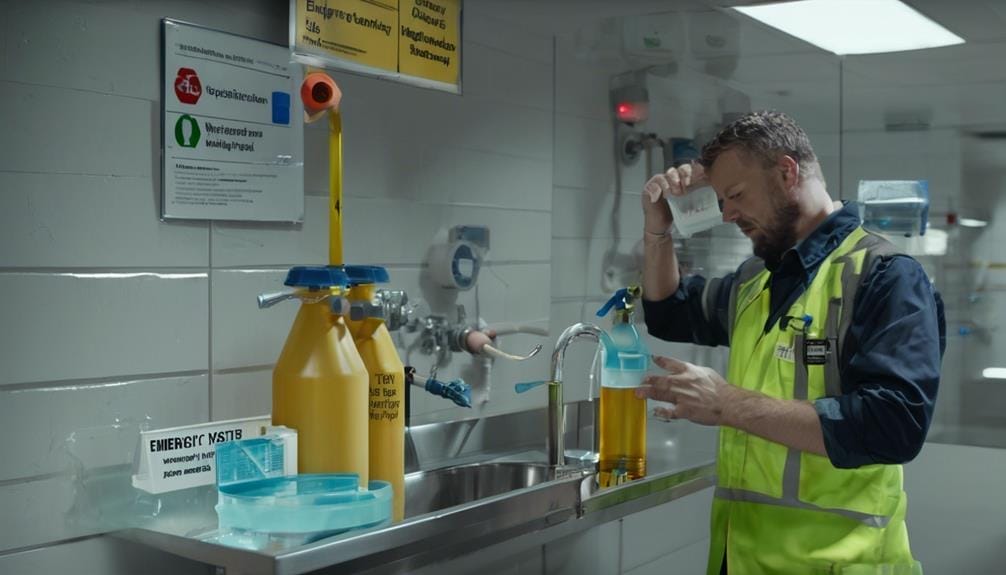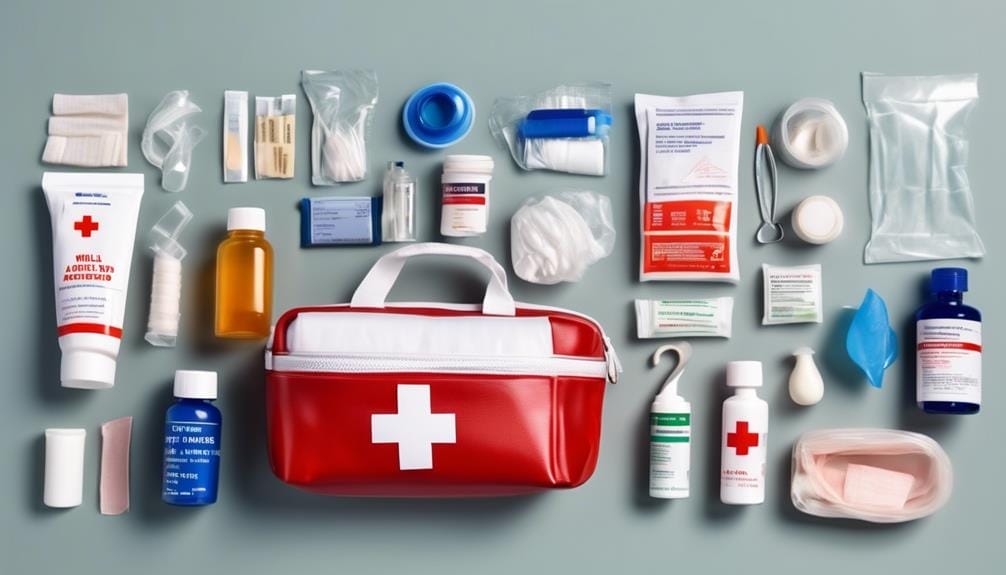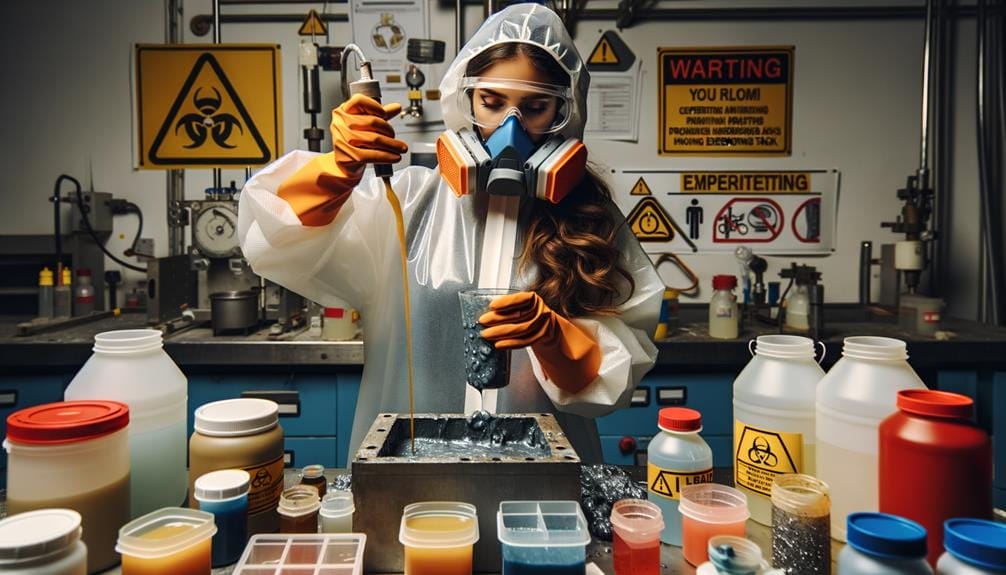Did you know that handling liquid glass epoxy requires specific safety equipment to ensure your protection? While it may seem like a straightforward task, there are potential risks involved that you might not be aware of.
By using the right safety equipment, you can minimize the chances of accidents and protect yourself from potential harm. In this discussion, we will explore the various types of safety equipment needed when working with liquid glass epoxy, including gloves, goggles, respirators, protective clothing, face shields, emergency eyewash stations, fire extinguishers, and first aid kits.
So, let's dive into this important topic and learn how to keep ourselves safe while handling liquid glass epoxy.
Key Takeaways
- Personal protective equipment (PPE) is crucial when handling liquid glass epoxy to ensure protection from harmful chemicals.
- Proper hand protection, such as nitrile or latex gloves, should be used in conjunction with other protective clothing to minimize skin exposure.
- Safety goggles with side shields or a full-face shield should be worn to protect the eyes from epoxy splashes.
- Selecting the right respiratory protection, such as the appropriate respirator, is important for filtering out airborne particles and fumes.
Importance of Safety Equipment
Proper safety equipment is essential when handling liquid glass epoxy to ensure the protection of your skin and eyes from potential exposure to harmful chemicals. To maintain safety while working with epoxy resin, it's crucial to wear the appropriate personal protective equipment (PPE).
This includes wearing gloves, an apron, and safety goggles. Gloves provide a barrier between your skin and the epoxy resin, preventing direct contact and reducing the risk of skin irritation or chemical burns. An apron helps protect your clothing from accidental spills or splashes, minimizing the chance of exposure to the epoxy resin. Safety goggles are essential to shield your eyes from potential splashes or fumes, which can cause serious eye irritation or damage.
Additionally, it's important to ensure good ventilation in your workspace. This can be achieved by using fans or opening windows to minimize exposure to toxic fumes released by the epoxy resin.
Gloves for Hand Protection
To protect your hands while working with liquid glass epoxy, it is important to wear gloves made of nitrile or latex. These materials provide a barrier between your skin and the resin liquids, preventing direct contact and potential skin irritation or burns. It is crucial to prioritize the right size and fit of gloves to ensure maximum hand protection.
To emphasize the importance of wearing gloves, consider the following table:
| Gloves | Material | Features |
|---|---|---|
| Nitrile | Synthetic | Resistant to oils, chemicals, and punctures |
| Latex | Natural | Offers flexibility and sensitivity |
When working with liquid epoxy, it is vital to take safety precautions. Always refer to the safety data sheets provided by the manufacturer for specific handling and protection guidelines. In the event of resin contact with the skin, clean it promptly using baby wipes or soap and water. Additionally, wearing a plastic apron can effectively prevent spills and drips, reducing the risk of skin exposure. Remember to prioritize eye protection as well by using safety goggles. By following these safety measures and wearing the appropriate gloves, you can ensure the safety of your hands while working with liquid glass epoxy.
Goggles for Eye Safety

When working with liquid glass epoxy, protecting your eyes is crucial, and goggles are essential for ensuring eye safety. Goggles provide the necessary eye protection from potential splashes or fumes that may occur during the handling of liquid glass epoxy.
It's important to choose goggles that have side shields or a full-face shield to provide comprehensive coverage and protect your eyes from all angles. When selecting goggles, opt for ones specifically designed for chemical splash protection to safeguard against the epoxy resin. Additionally, prioritize goggles that have a snug fit to prevent any gaps that could allow the epoxy to reach your eyes.
Regularly inspect and maintain your goggles to ensure they provide optimal eye safety. Remember, safety glasses or goggles are a vital part of your personal protective equipment (PPE) when working with liquid glass epoxy, as they protect your eyes from potential hazards and ensure a safe working environment.
Respirators for Respiratory Protection
To ensure proper respiratory protection while handling liquid glass epoxy, it's essential to select the right respirator. Refer to the epoxy resin safety data sheet to determine the specific respirator requirements for the task.
Additionally, it's crucial to ensure a proper fit by conducting respirator fit testing.
Proper Respirator Selection
For secure and effective protection against epoxy fumes, it is essential to select a NIOSH-approved respirator that fits properly and is purchased from a reputable supplier. When choosing a respirator for handling liquid glass epoxy, refer to the resin's safety data sheet for specific recommendations regarding respiratory protection. Prioritize proper respirator selection to safeguard against inhaling harmful vapors. Here is a table to guide you in selecting the appropriate respirator:
| Respirator Type | Description | Application |
|---|---|---|
| N95 | Filters out 95% of airborne particles, including epoxy fumes. | Suitable for low-level exposure and short-term use. |
| Half-face | Covers the nose and mouth, providing a secure seal. | Ideal for moderate to high-level exposure. |
| Full-face | Covers the entire face, including eyes, and provides the highest level of protection. | Recommended for long-term exposure and high-risk scenarios. |
Remember to ensure proper ventilation in the work area and follow all safety guidelines when handling liquid glass epoxy.
Respirator Fit Testing
To ensure optimal protection against epoxy fumes, it's crucial to conduct proper fit testing for respirators used during the handling of liquid glass epoxy. Fit testing determines whether the respirator forms a proper seal on your face, ensuring that harmful fumes and particles are effectively filtered out.
Here are some key points to consider regarding respirator fit testing:
- Fit testing should be conducted annually or whenever there's a change in facial features or respirator model.
- Both half-face and full-face respirators require fit testing to ensure their effectiveness.
- Proper fit testing is essential for preventing skin exposure to the curing agent and resin safely.
Protective Clothing for Body Cover

To ensure full-body protection while handling liquid glass epoxy, it's essential to wear chemical-resistant coveralls that shield your body from chemical splashes and skin contact.
For hand safety, opt for gloves made with materials like EVOH laminate, butyl rubber, nitrile rubber, or neoprene.
Additionally, protect your eyes by wearing safety goggles to prevent any accidental splashes from reaching your eyes.
Coveralls for Full-Body Protection
Why is it important to wear coveralls for full-body protection when handling liquid glass epoxy?
Coveralls are essential for ensuring complete protection when working with liquid glass epoxy. Here are three key reasons why you should wear coveralls:
- Prevents skin contact: Coveralls provide a barrier between your skin and the epoxy resin, minimizing the risk of skin contact and potential hazards. This is particularly important as epoxy resin can cause skin irritation and allergic reactions.
- Chemical-resistant material: Coveralls made with chemical-resistant materials, such as PVC, offer superior protection against chemical splashes and spills. They're designed to withstand exposure to epoxy resin, ensuring your safety during handling.
- Compliance with safety guidelines: Wearing coveralls is recommended by the safety data sheet (SDS) for liquid glass epoxy. Following these guidelines is crucial to maintain a safe working environment and prevent any accidents or injuries.
Additionally, it's important to complement your coveralls with other protective gear, such as latex gloves, sturdy boots, and shoe covers, to ensure comprehensive full-body protection.
Gloves for Hand Safety
For optimal hand safety and protection when handling liquid glass epoxy, it's crucial to wear gloves as part of your overall protective clothing. When choosing gloves, opt for those made of nitrile or latex, as they offer protection against resin liquids and potential skin irritation.
It's important to ensure that the gloves fit properly and provide adequate coverage to prevent any direct contact with the epoxy resin. For added protection against potential skin contact with corrosive substances, consider using chemical-resistant gloves.
Remember to use gloves in conjunction with other protective clothing, such as a plastic apron, to minimize the risk of skin exposure to resin and chemical splashes.
Safety Goggles for Eye Protection
Ensure your safety and protect your eyes from potential splashes and fumes by wearing safety goggles when handling liquid glass epoxy. Safety goggles provide essential eye protection from potential splashes and fumes when working with liquid glass epoxy. Ensure the safety goggles fit snugly and have side shields for complete eye protection. Safety goggles are an integral part of personal protective equipment (PPE) when handling liquid glass epoxy.
Safety Shoes for Foot Protection

Invest in safety shoes with toe caps and slip-resistant soles for optimal foot protection when handling liquid glass epoxy. These safety shoes are essential to protect your feet from impacts and compression that may occur in the work area. The toe caps provide an additional layer of protection against any heavy objects that may accidentally fall on your feet. Slip-resistant soles are crucial to prevent slips and falls, especially in resin work areas where the floor may become slippery.
It is important to ensure that the safety shoes fit properly and provide ankle support for stability. Ill-fitting shoes may cause discomfort or hinder your movement, which can be unsafe when working with liquid glass epoxy. Look for safety shoes made of chemical-resistant materials to protect against spills or splashes of epoxy. This will ensure that your feet remain safe even if there's an accidental spill on the work surface.
Remember to regularly inspect your safety shoes for any signs of wear and tear. If you notice any damage, it's crucial to replace them immediately to maintain the level of foot protection required when handling liquid glass epoxy.
In addition to safety shoes, don't forget to wear nitrile gloves for hand protection while working with epoxy. By wearing the appropriate personal protective equipment, you can ensure that your work with liquid glass epoxy is safe and secure.
Face Shields for Face and Neck Safety
When it comes to face and neck safety while handling liquid glass epoxy, full-face protection is crucial.
Face shields provide a clear, impact-resistant barrier that shields your entire face and neck area from potential splashes and spills.
These shields are designed to be worn over safety goggles, offering comprehensive protection against liquid glass epoxy and ensuring your overall safety.
Full-Face Protection
For complete face and neck safety when handling liquid glass epoxy, utilizing full-face protection, such as face shields, is essential. Face shields provide comprehensive coverage and offer protection against splashes, fumes, and airborne particles, ensuring safety during resin handling. These shields are designed to offer a clear field of vision while guarding the entire face, making them indispensable for complete protective coverage.
When working with epoxy resin, accidental contact can pose a significant risk, but face shields act as an effective barrier, providing an additional layer of defense alongside other protective equipment. Investing in a quality face shield specifically designed for chemical and impact resistance is crucial for ensuring complete face and neck safety.
Remember to always handle epoxy resin at the proper temperature and use the appropriate safety equipment to minimize risks.
Neck Guard Options
To ensure comprehensive face and neck safety while working with liquid glass epoxy, it's crucial to consider neck guard options in addition to utilizing face shields.
When selecting a neck guard, it's important to prioritize features that will provide optimal protection. Look for a face shield with an extended neck guard to shield the neck from resin splashes. Ensure the face shield has an adjustable neck strap for a secure and comfortable fit during the epoxy handling process.
Additionally, choose a face shield with anti-fog and scratch-resistant properties to maintain clear visibility and durability. Evaluate face shields with UV protection to safeguard against resin curing under UV light. Lastly, prioritize face shields made from impact-resistant materials to protect the face and neck effectively while working with epoxy and chemicals.
Emergency Eyewash Stations for Immediate Eye Rinse

Before handling epoxy resin, it's crucial to locate and familiarize yourself with the nearest eyewash station for immediate eye rinsing. Eyewash stations are essential safety equipment that provide immediate irrigation to flush eyes in case of contact with epoxy resin.
Here are some key points to consider about emergency eyewash stations:
- Locate and Familiarize: Take the time to identify the nearest eyewash station in your work area. Familiarize yourself with its location, ensuring you can easily access it in case of an emergency.
- Instruct Others: It's important to educate your colleagues or anyone working with epoxy resin about the location and proper usage of eyewash stations. In an emergency, everyone should be aware of the nearest station and how to operate it effectively.
- Regular Check-ups: Routine inspections of eyewash stations are crucial. Ensure they're fully operational and unobstructed. Regular maintenance and testing should be carried out to guarantee they're ready for immediate use in case of an eye injury.
Fire Extinguishers for Fire Safety
After familiarizing yourself with the location and proper usage of emergency eyewash stations, it's important to also understand the importance of having fire extinguishers for fire safety.
When working with liquid glass epoxy, which is commonly used for clear coating applications, there's a potential risk of fire. Having the appropriate fire extinguishers on hand is essential to ensure the safety of yourself and others.
It's crucial to have the right type of fire extinguisher for the specific type of fires you may encounter. Class A fire extinguishers are suitable for fires involving ordinary combustible materials like wood or paper, while Class B extinguishers are designed for flammable liquids such as epoxy resin. Additionally, Class C extinguishers are specifically for electrical fires.
Regularly inspect and maintain your fire extinguishers to ensure they're in good working condition. Familiarize yourself with the proper operation of the fire extinguisher, including the PASS technique (Pull, Aim, Squeeze, Sweep).
Place fire extinguishers in easily accessible locations and ensure that everyone in the area knows their locations. It's also worth considering training employees or family members on how to properly use a fire extinguisher in case of an emergency.
First Aid Kits for Immediate Medical Attention

Ensure that you have a well-stocked first aid kit readily available in the work area for immediate medical attention. Here are some essential items to include in your first aid kit:
- Adhesive bandages, gauze, antiseptic wipes, and medical tape: These items are crucial for treating minor injuries that may occur while handling liquid glass epoxy. Clean any cuts or scrapes with soap and water, and then apply an adhesive bandage or gauze to cover the wound. Use antiseptic wipes to prevent infection, and secure the bandage with medical tape.
- Eye wash solution or eye drops: Accidental exposure to epoxy resin can cause irritation or injury to the eyes. In case of contact, immediately flush the eyes with water or use an eye wash solution. If irritation persists, seek medical attention.
- Burn cream or gel: Epoxy resin can cause minor burns upon contact with the skin. Apply a burn cream or gel to soothe the affected area. If the burn is severe, seek medical attention.
Remember to wash your hands thoroughly with soap and water after handling liquid glass epoxy to remove any residue.
If you have any concerns or require further assistance, don't hesitate to contact us or seek medical help.
Frequently Asked Questions
What Are the Safety Precautions for Epoxy?
To handle epoxy safely, wear gloves, ensure good ventilation, and refer to the safety data sheet for respirator requirements. Accidental contact should be cleaned off immediately with baby wipes and soap and water.
Do You Need PPE for Epoxy Resin?
Yes, you need PPE for epoxy resin. It's crucial to protect yourself from potential health risks. Wear gloves, safety goggles, and a plastic apron. Ensure good ventilation or use fans. PPE alternatives are not recommended.
Do You Need to Wear a Respirator When Using Epoxy?
You absolutely need to wear a respirator when using epoxy. The fumes can pose serious health risks. Ensure your safety by properly ventilating the area and using a NIOSH-approved respirator for maximum protection.
Is Epoxy Safe to Handle?
Yes, epoxy is generally safe to handle when proper safety measures are followed. It's important to use gloves, goggles, and work in a well-ventilated area. There are alternative materials available, and epoxy waste should be disposed of safely.
Conclusion
In conclusion, when handling liquid glass epoxy, it's essential to prioritize safety by using the proper protective equipment. Wearing gloves, goggles, and respiratory protection, along with utilizing good ventilation, ensures a safe working environment.
An interesting statistic to note is that according to a study, 40% of epoxy resin accidents occur due to inadequate safety measures.
By following these guidelines, we can significantly reduce the risk of accidents and protect ourselves while working with liquid glass epoxy.





